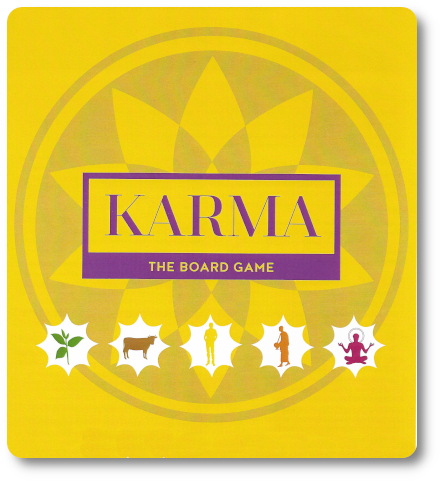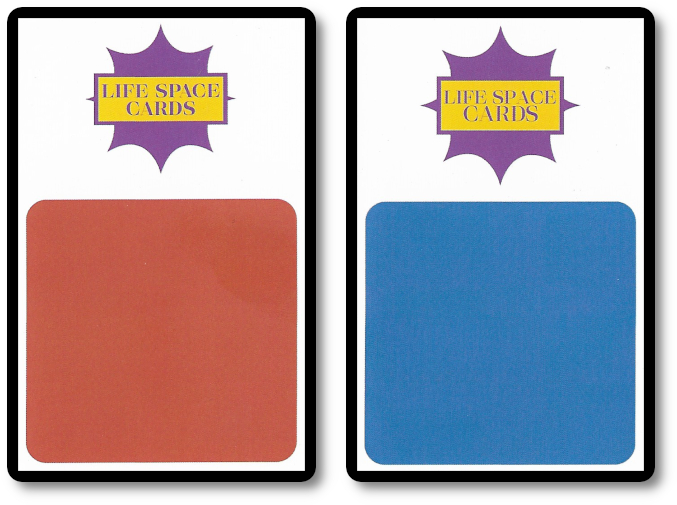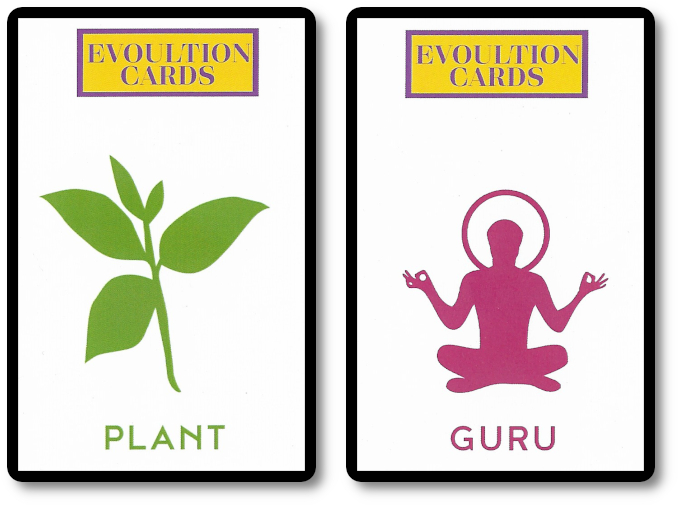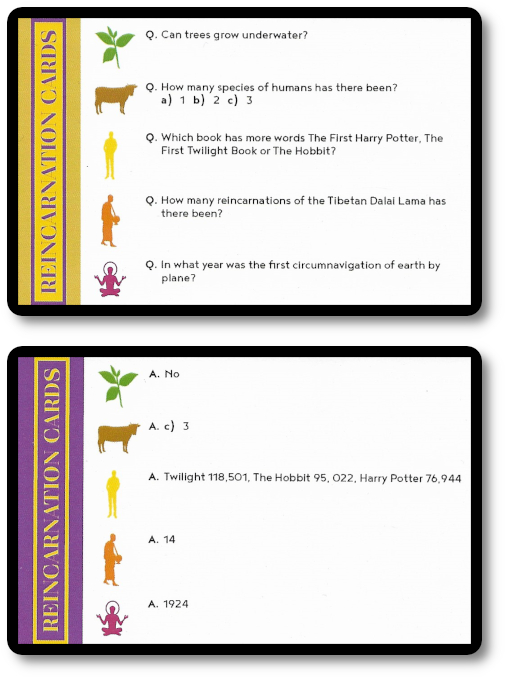Please Take Note: This is a review of the final game, but it might change slightly based on the Kickstarter campaign’s success. The game is being reviewed on the components and the rules provided with the understanding that “what you see is not what you might get” when the game is published. If you like what you read and want to learn more, we encourage you to visit the game’s website or visit the Kickstarter campaign. Now that we have all that disclaimer junk out of the way, on with the review.

The Basics:
- For ages 12 and up
- For 2 to 6 players
- Approximately 60 minutes to complete
Geek Skills:
- Active Listening & Communication
- Counting & Math
- Logical & Critical Decision Making
- Reading
- Hand/Resource Management
Learning Curve:
- Child – Easy
- Adult – Easy
Theme & Narrative:
- Obtain enlightenment through trivial pursuits
Endorsements:
- Gamer Geek rejected!
- Parent Geek rejected!
- Child Geek rejected!
Overview
American self-help spiritual author and motivational speaker Wayne Dyer said: “How people treat you is their karma; how you react is yours.” Karma is a way to look at the universe through a spiritual lens of cause and effect that influences one’s ability to evolve via enlightenment and through levels of existence. Or, in this case, play a trivia game. Traverse the spheres, challenge yourself with questions, and earn the reward to reach the ultimate enlightenment.
Karma: The Board Game, designed by Gregory Scathcart and to be published by Boxcar Games, will reportedly be comprised of one game board, six Playing pieces, 100 Karma cards, 100 Reincarnation cards, 29 Life cards, 30 Evolution cards, one Karma Wheel, 150 colored Karma chips, and one standard six-sided die. As this is a review of a prepublished game, I cannot comment on the final game component quality. However, the early release version of this game was assembled and published by The Game Crafter, which meant we played with high-quality components (yes, I am shamelessly promoting my friends).
Starting the Cycle
To set up the game, first place the game board in the middle of the playing area. Any individual familiar with Eastern religions will immediately recognize that the board’s layout is similar to a Saṃsāra, which depicts the continuous cycle of death and rebirth. Sort of. It’s fairly abstract, but if you know your stuff, you’ll see it. Everyone else will see a board with pretty colors, which is also fine.

Second, give each player 1000 points worth of Karma chips. These come in the value of “100” and “50”. Place all remaining Karma chips in a pool off to one side of the playing area.
Third, give each player a Playing piece of their choice and direct them to place it on the starting “Plant” reincarnation space on the game board.
Fourth, shuffle the cards into separate decks and place them face-down next to the game board.
That’s it for game set up. Determine who will go first and begin.
A Journey of Evolution
Karma: The Board Game is played in rounds and turns with no set number of rounds per game. A player’s turn is summarized here.
Step One: Roll the Die
The player takes the die and rolls it. The resulting value indicates how many spaces the player must move on their turn.
Step Two: Move Player Piece
The player now moves their Player piece around the game board. The direction around the board is up to the player, but the total number of spaces moved must equal the number value rolled. For example, if you roll a “4”, you must move four spaces, either clockwise or counterclockwise.
There are three tracks on the game board referred to as “spheres.”
Earth Sphere
This is considered the “outer sphere” and is represented by the spaces that are the furthest out on the circle. From this sphere, a player can obtain the “Plant,” “Animal,” “Human,” and “Monk” Evolution cards.
Heaven Sphere
This is considered the “inner sphere” and is represented by spaces inside the circle. Players can only jump to this track if they have obtained the “Plant,” “Animal,” “Human,” and “Monk” Evolution cards. While they travel the inner sphere, they can obtain the “Guru” Evolution card and a chance to reach ultimate enlightenment.
Purgatory
It is less a sphere and more a “temporary jail,” as it resides between the outer and inner sphere. Players are sent to Purgatory – again, temporarily – if they lose all their Karma chips. While in Purgatory, players miss their next turn in the round. Exiting Purgatory requires the player to discard one Life Space card or one Evolution card of their choice. If the player is unable to pay Karma chips, any opponent can choose to pay for them, thus allowing a player to avoid Purgatory altogether. Upon exiting Purgatory, the player’s Player piece is placed on any space on the Earth Sphere.
Step Three: Resolve Space
After the Player piece is moved, it’s time to resolve the space it stops on. There are four different spaces.
Life Space
Ending movement on this space awards the player with a Life card that matches the color of the game board space. Life cards are collected throughout the game and are used to gain merit from other players by giving them away, bought from opponents, sold, or even traded. Think of Life Space cards are free-wheeling currency with no inherent value except that you perceive.

Reincarnation Space
Ending movement in this space allows the player to move up the evolutionary ladder. Everyone starts as a plant, moves to an animal, then a human, followed by an enlightened monk, and finally, a guru. The ultimate level of evolution – and enlightenment – is the lotus. Enlightenment “leveling up” is tracked using Evolution cards.

To evolve, however, requires you to be smart. The opponent to the player’s right now draws a Reincarnation card and reads the card’s text aloud based on the evolutionary advancement the Player piece landed on. The Reincarnation cards are similar to other trivia games, wherein the question is on one side, and the answer is on the other. Questions range from yes or no responses, short answers, acting things out, and multiple choice. If the player answers the questions correctly, they collect a matching Evolution card.

It’s possible to have more than one of the same Evolution card types, which is handy if you want to trade and interact with other players. It should also be noted that evolution is not sequential. A player can obtain Evolution cards from any level.
Second Chance Karma
Reincarnation spaces allow the player to attempt to evolve for free. Second Chance Karma spaces allow the player to take the same action as a Reincarnation space, but they must pay – using Karma chips – for the question they want. The higher up the evolutionary ladder, the more Karma chips the player must pay.
Karma
Ending movement on this space gives the player good karma or bad karma, as determined by a random draw and resolution of a Karma card. Sometimes by default or the result of completing an action or answering a question. Some Karma cards also move the player’s piece on the game board. If a player is unable to pay the penalty, they are sent to Purgatory.

End of the Round and Karma Negotiation
When the last player has completed their turn in sequential order, the round comes to an end. All players now enter into Karma Negotiation, which is a fancy way of saying they can now trade cards. Cards can be swapped, bought, and sold with Karma chips and even given away if the player likes. All deals are in front of all the other players. Feel free to auction and make deals one at a time or all at once.
After all players have completed their Karma Negotiations, the Karma wheel is spun. One player spins the wheel. Where the spinner ends will point to one of four possible colors. Players now see how many Life Space cards of that color they have in their possession and collect a set number of Karma chips from other players.
This ends the round. A new round begins, and the game continues until…
Reaching Ultimate Enlightenment
The game ends when a player has earned at least one of each of the Evolution cards and has completed at least one full rotation via movement in the Heaven Sphere with a “Guru” Evolution card in their possession, landing again on the “Guru” space. From there, the player moves their Player piece to the center of the board on the lotus space, symbolizing they have obtained ultimate enlightenment.
But victory is still not given to the player without first a challenge.
The player is asked a question from any available on the Reincarnation card. If the player answers it successfully, they win! If they fail to do so, they are moved back to the “Guru” space and must again make a trip around the Heaven sphere.
To learn more about Karma: The Board Game, visit the game’s website or visit the Kickstarter campaign.
Final Word
 The Child Geeks didn’t care for the game, finding it fun at first, but it demanded too much of their time and attention for too long. According to one Child Geek, “When it is your turn, you have little to do, and if you can’t answer the question, you didn’t get anything fun done. That happened to me a lot.” Another Child Geek said, “I liked it at first, but the questions got harder, and I didn’t know the answers. I stopped being interested when it was obvious I couldn’t play.” Trivia games are hard, even those that give players the answers or make the number of possible choices very few to consider. When the last enlightening question was answered, the Child Geeks voted not to take the journey with Karma: The Board Game, again.
The Child Geeks didn’t care for the game, finding it fun at first, but it demanded too much of their time and attention for too long. According to one Child Geek, “When it is your turn, you have little to do, and if you can’t answer the question, you didn’t get anything fun done. That happened to me a lot.” Another Child Geek said, “I liked it at first, but the questions got harder, and I didn’t know the answers. I stopped being interested when it was obvious I couldn’t play.” Trivia games are hard, even those that give players the answers or make the number of possible choices very few to consider. When the last enlightening question was answered, the Child Geeks voted not to take the journey with Karma: The Board Game, again.
 The Parent Geeks found the questions interesting, but the gameplay altogether dull. According to one Parent Geek, “The game reminded me a lot of Trivial Pursuit, where I had to travel around and around to get little pieces of a pie. Except in this game, I needed to collect cards. I still went in circles, and I still felt like all I was doing is rolling dice and answers questions. Most of the time, poorly. The game didn’t interest me.” Another Parent Geek said, “A neat idea for what is essentially just a trivia game, although it is themed. I’ve played other themed trivia-like games but never one that is based on Eastern religion and philosophy. Interesting concept, but the gameplay wasn’t.” When the last soul reached enlightenment, the Parent Geeks found nothing enlightening about the game to discuss.
The Parent Geeks found the questions interesting, but the gameplay altogether dull. According to one Parent Geek, “The game reminded me a lot of Trivial Pursuit, where I had to travel around and around to get little pieces of a pie. Except in this game, I needed to collect cards. I still went in circles, and I still felt like all I was doing is rolling dice and answers questions. Most of the time, poorly. The game didn’t interest me.” Another Parent Geek said, “A neat idea for what is essentially just a trivia game, although it is themed. I’ve played other themed trivia-like games but never one that is based on Eastern religion and philosophy. Interesting concept, but the gameplay wasn’t.” When the last soul reached enlightenment, the Parent Geeks found nothing enlightening about the game to discuss.
 The Gamer Geeks found Karma: The Board Game to be little more than a trivia game with strange questions and unnecessary rules. According to one Gamer Geek, “I find most trivia games boring, and this one is no exception. Even the need to trade with other players feels unwarranted and is not something you really want to do in many respects. This is not a game I would want to play again.” Another Gamer Geek said, “No thanks. Not a game I found interesting, the questions I found to be either offputting or overtly random, and I didn’t feel I was making progress in the game that felt rewarding. Even after I won, I don’t remember feeling exciting about it. And rolling dice to force your movement and a spinner wheel? Yuck. No.” When the lotus flower bloomed, the Gamer Geeks didn’t see much to be excited about.
The Gamer Geeks found Karma: The Board Game to be little more than a trivia game with strange questions and unnecessary rules. According to one Gamer Geek, “I find most trivia games boring, and this one is no exception. Even the need to trade with other players feels unwarranted and is not something you really want to do in many respects. This is not a game I would want to play again.” Another Gamer Geek said, “No thanks. Not a game I found interesting, the questions I found to be either offputting or overtly random, and I didn’t feel I was making progress in the game that felt rewarding. Even after I won, I don’t remember feeling exciting about it. And rolling dice to force your movement and a spinner wheel? Yuck. No.” When the lotus flower bloomed, the Gamer Geeks didn’t see much to be excited about.
 Unfortunately, none of our groups found Karma: The Board Game to be particularly interesting or engaging. And therein lies one of the most difficult aspects of game design when attempting to create a trivia game. Trivia games require the player to have a certain amount of knowledge BEFORE they sit at the table. If they don’t, they cannot possibly hope to compete. Karma: The Board Game attempts to circumvent this by allowing players to exchange cards for other cards, thus allowing players to obtain needed items that are normally earned through questions and answers. While it does sound like a good approach, there is nothing in place to make this sort of activity appealing to winning players. The question “why would I want to give you that card?” came up a lot. Not once was an answer provided that was reasonable. Although a few times players tried the “because I love you” or “if you don’t, I’ll cancel Christmas.”
Unfortunately, none of our groups found Karma: The Board Game to be particularly interesting or engaging. And therein lies one of the most difficult aspects of game design when attempting to create a trivia game. Trivia games require the player to have a certain amount of knowledge BEFORE they sit at the table. If they don’t, they cannot possibly hope to compete. Karma: The Board Game attempts to circumvent this by allowing players to exchange cards for other cards, thus allowing players to obtain needed items that are normally earned through questions and answers. While it does sound like a good approach, there is nothing in place to make this sort of activity appealing to winning players. The question “why would I want to give you that card?” came up a lot. Not once was an answer provided that was reasonable. Although a few times players tried the “because I love you” or “if you don’t, I’ll cancel Christmas.”
Overall, I found Karma: The Board Game’s approach to the theme to be interesting, but not empowering or really – and you’ll excuse the pun – enlightening. I didn’t learn much other than some random answers to random questions. It felt like a race I was running but without the drive to finish it. For trivia game lovers, Karma: The Board Game is sure to entertain to a certain degree, but for everyone else, this game about karma didn’t deliver on its good intentions.
This is a paid-for review of the game’s final prototype. Although our time and focus were financially compensated, our words are our own. We’d need at least 10 million dollars before we started saying what other people wanted. Such is the statuesque and legendary integrity of Father Geek, which cannot be bought except by those who own their private islands and small countries.




Who designed the game?
Gregory Scathcart